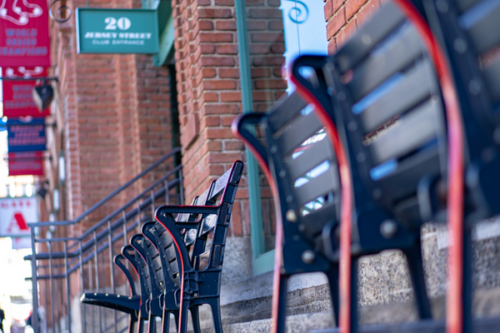As the COVID-19 pandemic raged on in the fall of 2020, election officials needed easily accessible polling sites that allowed for ample social distancing. The perfect locations: professional sports stadiums and arenas. Connected to public transportation, familiar to residents, and with room to space out voters, over 48 MLB, NBA, NHL, MLS, and NFL sports stadiums and arenas were used for early and Election Day voting in 2020.
To better understand how effective professional sports stadiums and arenas were as polling locations, we sat down with Ash Center Senior Practice Fellow in American Democracy Tova Wang, who recently co-authored a new Civic Responsibility Project report, Voting In 2020: Professional Sports Stadiums & Arenas As Polling Places, alongside Frank Guridy, Columbia University; Michael Hammer, University of Maryland; David Nickerson, Temple University; and Robert Stein, Rice University.
Ash: Was there a clear demographic or partisan difference in who took advantage of voting in a professional sports stadium or arena?
Tova Wang: From what we could ascertain from just one and one pretty crazy [2020] election, no. It varied by place, and there was no consistent pattern. Just as important our polls and surveys showed that great majorities of people from both parties support stadium voting. In other words, it’s not a polarizing, controversial, or partisan thing to do. It’s simply something that teams can do to better serve the communities in which they live.
The best available data seems to show that utilizing stadiums or arenas as polling locations has little impact on voter turnout. Why do you think this is?
We don’t know what the impact on turnout was. We just didn’t have sufficient data, and 2020 was such an anomalous election. Moreover, in 2020 all of this was conceived of, planned, and implemented completely on the fly. There was no time for planning or outreach. Going forward there will be a much bigger effort to do voter education and voter outreach. This includes going to the sports press and leveraging other creative publicity that there just wasn’t the time to put in place for 2020. Teams and athletes have a platform and can attract attention that is much different than other modes of reaching voters. Finally, people were not traveling to downtown areas for their jobs, or really moving around much at all because of the pandemic. So that was another factor that made using this election as a gauge difficult.
What other incentives do professional sports teams and election officials have to continue utilizing stadiums and arenas as polling locations?
Probably the biggest takeaway from this research is that stadiums and arenas make excellent polling sites. They are big, have parking, are usually near mass transit, and have other practical advantages. In addition, the teams know how to do this – that is, put on an event, move big numbers of people, make efficient use of space, and make sure lines move. That also meant that wait times were shorter at stadiums and using them may have alleviated lines at other voting sites. And teams and local elections officials engaged in these truly wonderful partnerships, working together with mutual respect and commitment to supporting democracy. They were able to collaborate recognizing what each knew best and was capable of.
For teams, this is a great way to give back to the community. This is especially true given the amount of public money they get to build and renovate the stadiums. Teams genuinely want to be good community partners and civic citizens. As it turned out, serving as a polling site was a fairly easy way for them to engage. And there was virtually no public backlash to their doing so.
“Our research demonstrates that teams do not need to shy away from supporting democracy”
We’ve seen a marked increase in professional sports teams getting more involved in social justice issues and encouraging voter participation. For example, after the most recent mass shootings in Uvalde, Texas, and Buffalo, New York both the Tampa Bay Rays and the Yankees used their social media platforms to share gun violence statistics. What do you think is driving this change?
The massive protest movement provoked by the murder of George Floyd in Minneapolis in May 2020 was a catalyzing moment. Athletes joined the millions of people who took to the streets to express their outrage at the callous murder of Floyd by the police. Black athletes in particular took the lead, as they had been doing since the Movement for Black Lives emerged following the murders of Trayvon Martin and Michael Brown years before. Black and non-Black staff members of these franchises also pressured their leadership to take a stand for racial justice.
This pressure clearly provoked a renewed sense of civic responsibility among sports franchises. As the protests continued to grow in the weeks after Floyd’s murder, athletes and sports teams sought to produce concrete strategies to address racial injustice. This response was historically significant because it showed that sports franchises were willing to move beyond their reluctance to engage in politics and rely heavily on philanthropy for their community engagement activities. We believe the positive attitude of team and league officials reflects a new attitude of sports franchises toward civic engagement. Now the key will be to maintain the pressure on leadership to continue to take these stances and engage in these activities.
As we head towards the 2022 elections, what advice do you have for election officials looking to leverage a professional stadium as a polling location?
It’s might be too late for most stadiums to be used in the 2022 election. There are plans to use sports facilities in Cleveland this year. But now is the perfect time to start planning for 2024. With the increased lead time, elections officials and team staff can work on doing a better job of organizing stadium voting and improve substantially on letting people know about this voting option. Teams and athletes have a unique ability to draw the attention of people who might not be consistently engaged in elections. They also have the PR apparatus to do much more outreach to a broad range of local communities. Local elections officials had no problem working with the teams in 2020 in much more extreme circumstances. Now that people know it’s not as hard as it might seem, we hope there will be a continued willingness to work together.
What advice do you have for professional teams looking to increase their civic contributions?
Our research demonstrates that teams do not need to shy away from supporting democracy. They can do more to harness the sense of identity fans of the team have with the organization to encourage civic engagement. These types of efforts are contributions to the community and a way of partnering with the community. Teams and owners of these spaces should give back to the local area by making them available for a range of civic activities including but not limited to voting. For example, stadiums were used for COVID-19 testing and vaccines too, and very successfully. There are a lot of times these spaces are not being used when they could be used to encourage democratic participation.







